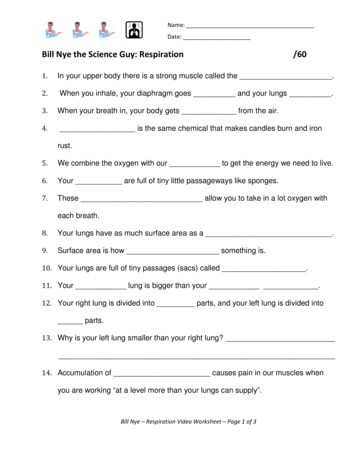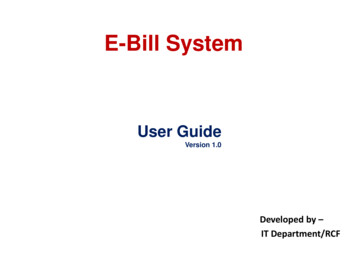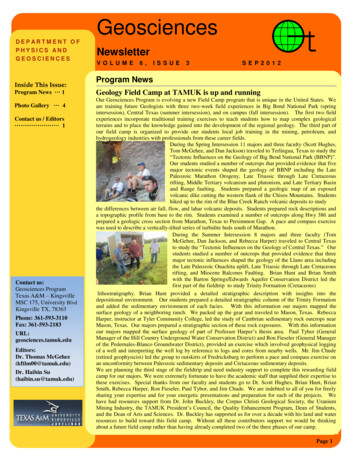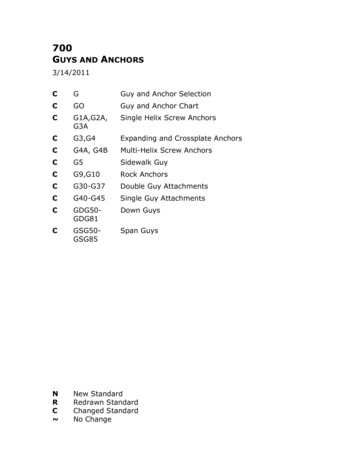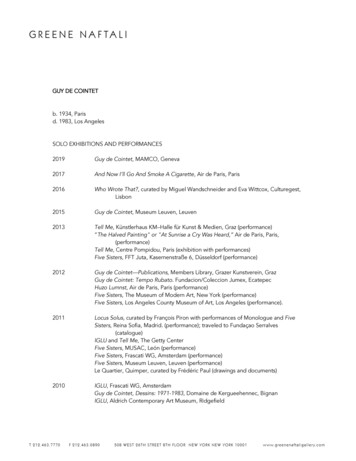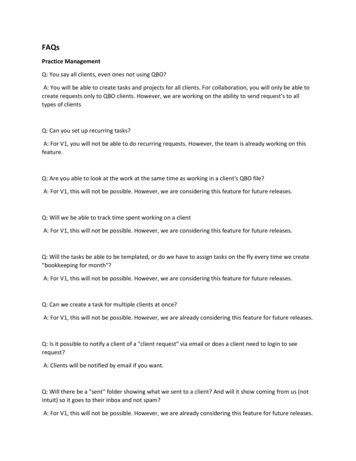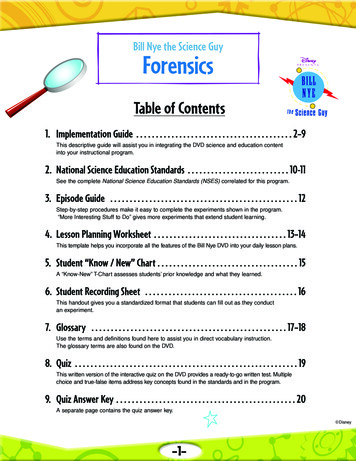
Transcription
Bill Nye the Science GuyForensicsTable of Contents1. Implementation Guide . . . . . . . . . . . . . . . . . . . . . . . . . . . . . . . . . . . . . . . . 2–9This descriptive guide will assist you in integrating the DVD science and education contentinto your instructional program.2. National Science Education Standards . . . . . . . . . . . . . . . . . . . . . . . . . . 10-11See the complete National Science Education Standards (NSES) correlated for this program.3. Episode Guide . . . . . . . . . . . . . . . . . . . . . . . . . . . . . . . . . . . . . . . . . . . . . . . . 12Step-by-step procedures make it easy to complete the experiments shown in the program.“More Interesting Stuff to Do” gives more experiments that extend student learning.4. Lesson Planning Worksheet . . . . . . . . . . . . . . . . . . . . . . . . . . . . . . . . . . 13–14This template helps you incorporate all the features of the Bill Nye DVD into your daily lesson plans.5. Student “Know / New” Chart . . . . . . . . . . . . . . . . . . . . . . . . . . . . . . . . . . . . 15A “Know-New” T-Chart assesses students’ prior knowledge and what they learned.6. Student Recording Sheet . . . . . . . . . . . . . . . . . . . . . . . . . . . . . . . . . . . . . . . 16This handout gives you a standardized format that students can fill out as they conductan experiment.7. Glossary . . . . . . . . . . . . . . . . . . . . . . . . . . . . . . . . . . . . . . . . . . . . . . . . . . 17–18Use the terms and definitions found here to assist you in direct vocabulary instruction.The glossary terms are also found on the DVD.8. Quiz . . . . . . . . . . . . . . . . . . . . . . . . . . . . . . . . . . . . . . . . . . . . . . . . . . . . . . . . . 19This written version of the interactive quiz on the DVD provides a ready-to-go written test. Multiplechoice and true-false items address key concepts found in the standards and in the program.9. Quiz Answer Key . . . . . . . . . . . . . . . . . . . . . . . . . . . . . . . . . . . . . . . . . . . . . . 20A separate page contains the quiz answer key. Disney–1–
Implementation GuideWelcome to Disney’s Bill Nye DVD collection!With the help of this Guide you can bring instructionalDVDs into your science curriculum.What’s on the DVD?Bill Nye DVDs expand the educational features of Bill Nye the Science Guy programs. EachDVD provides students with science content through video clips aligned with National ScienceEducation Standards (NSES) and a host of other resources.Short video clips aligned with the NSES provide a unique opportunity for you to enhance your lessons usingDVD technology. Now you can show a video clip, or even short segments of a clip, on command. But there are ahost of other features, too! See the chart below for a summary.From theMainmenu, there are three chief sections:FeatureDescriptionWatch Program MenuFrom this menu, you can play the program straight through or use theclips to customize your viewing.Teacher SupportFrom this menu, you can access this Teacher’s Guide, the Glossary,Internet Links, and the Quiz.Bonus MaterialsUse this menu to try a different discussion starter, download a specialscreen-saver, or check out never-before-seen footage.From theWatch Program menu, you can:FeatureDescriptionPlay ProgramPlay the entire program from start to finish.Bilingual ModeView the entire program or clips in English or Spanish.Glossary ModeMake links to Glossary terms appear during the program.Program OverviewView the program introduction, in which Bill discusses the topic covered.Try ThisShow students demonstrating science concepts.Way Cool ScientistMeet a real scientist who talks about his or her area of study.Bill’s DemonstrationLook at a science demonstration conducted by Bill Nye.Music VideoEnjoy a short music video that summarizes the topic in an ageappropriate and entertaining manner.Science StandardsTake advantage of short video clips from the program, which arealigned with National Science Education Standards. Disney–2–
From theTeacher Support menu, you can:FeatureDescriptionScience QuizGive students a quiz to take independently or as a class. Seven to tenquiz items are aligned with the National Science Education Standards.The items are in multiple-choice or true-false format. Each wronganswer links to a standards-aligned video clip. At the end of the quiz,a scoring function reveals the number of correct initial answers.GlossaryCheck out definitions of key terms and view video clips thatreinforce the concepts.DVD FeaturesView a quick overview of the features found on the DVD.Teacher’s GuidePrint out or view this comprehensive Teacher’s Guide in PDF format.Internet LinkLink to the Bill Nye area of Disney’s Edustation Web site, where youcan find links to Internet sites related to the content of each BillNye program.From theBonus Materials menu, you can:FeatureDescriptionBonus MaterialFind out what wasn’t in the episode! In most cases, there’s moreof the Way Cool Scientist interview, Bill Nye outtakes, and anextra discussion starter.Additional ClipsSee trailers of related DVDs and videos.Screen-SaverDownload this cool screen-saver for your computer.The Planning ProcessThis Guide provides a Lesson Planning Worksheet (see page 12), which can assist you in settingup your instruction around a topic. The following sections of this Implementation Guide are offeredto assist your planning process: Determining Objectives and Linking to Standards The Learning Cycle Explore Apply Extend Assess Disney–3–
Determining Objectives and Linking to Standards1. The NSES Teaching Standard A states that science teachers must “select science contentand adapt and design curricula to meet the interest, knowledge, understanding, abilities, andexperience of students.”The NSES recommends that teachers “integrate . . . a practical structure for the sequence ofactivities, and the content to be learned.” The primary instructional model recommended bythe NSES is inquiry into authentic student-generated questions about natural or designedphenomena. Since most state and local standards documents were derived from the NSES,you will find that your local and state standards match closely with content standards in theBill Nye DVD.Each DVD contains a menu of clips that are aligned with the NSES. You can review thestandards and their aligned clips in the Science Standards menu under Watch Program. Also,the Standards listed on page 10 of this Guide allow you to look at additional NSES contentstandards that are addressed on the video. Here’s an example of the content standards andclips aligned with the Bill Nye DVD entitled Blood and Circulation:Life Science Standards (NSES) Addressed in Blood and CirculationLife Science:Structure and function in living systems Living systems at all levels of organization demonstrate the complementarynature of structure and function.Aligned clips: 12345Blood vesselsHeart pump and bloodstreamHeart valves and blood circulationWhite blood cellsCapillariesThe human organism has systems for digestion, respiration, reproduction,circulation, excretion, movement, control, and coordination, and for protection.Aligned clips: 6 Heart pump7 Heart muscle8 Pumping blood to brain Disney–4–
2. Determine your objectives for the lesson and how these objectives address the standards.Sample Objectives for Blood and CirculationIn this activity students will: Observe and describe a body system responsible for supply and transport. Use this information to define a body system. Ask questions about the circulatory system. Explain how structure complements function in organs of the circulatory system. Cite examples of current research related to this system.3. Design a learning cycle of instructional experiences and assessments for the students to engage inthat will help students meet these standards. Students may be given teacher-planned investigationsor may be guided to design their own investigations.The Learning CycleThe learning cycle is a sequence of activities that involve students in the learning process. Thesequence found here is based on research from Lawson, Abraham, and Renner published in 1989.That has been adapted to include: Explore, Apply, Extend and Assess:Explore: Involves assessing students’ prior knowledge and providing opportunities for studentsto interact with content from the video.Apply:Includes having students use the content learned during the Explore section in a newway that is meaningful to future learning.Extend: Allows students to conduct further research around an area of interest within the topic.Assess: Provides strategies meant to inform students and teachers about the content and processesthat have been learned.ExploreThe NSES Teaching Standard B states: “Teachers of science guide and facilitate learning.” Thisstandard addresses the constant need to balance your predetermined goals with allowing students toset and meet their own learning goals.Focus and Support Inquiries: Support student inquiries by making decisions about “when to provideinformation” and “when to connect students with other sources.” Knowing the best time to interveneis often determined by allowing students to ask questions and to explore concepts openly. Disney–5–
The NSES Teaching Standard C states: “Teachers of science engage in ongoing assessment of theirteaching and of student learning.”Assess in Order to Guide Teaching: The Program Overview or the Discussion Starter on the DVDcan be used to gauge students’ prior knowledge. You can use student responses to make decisionsabout appropriate instruction and adaptations in order to meet the needs of individual students.Assessment can be in the form of student reflections from standards-aligned video clips oranswers to questions found on the science quiz. Or, as in the following example, a simple graphicorganizer can facilitate a formative assessment.Example: T-Chart from Blood and Circulation1. Ask students to fill out the “Know-New” T-Chart (see page 14). Have them list what they alreadyknow about the circulatory system (heart, blood vessels, blood, etc.) on the left side of theircharts.2. Show the Program Overview for Blood and Circulation. On the right side of the chart, havestudents list new things they have learned from watching the clip. Walk around the room andassist students in filling in their T-Charts. Replay the program as necessary to allow students toreview sections of interest.3. Once students have completed their charts, ask them to share what they have listed in the“New” column. Write these on the board. Have students write their own working definitions ofthe circulatory system. Once students have completed their definitions, collect and review theirwork to assess prior knowledge.Conduct direct vocabulary instruction in the Explore phase. Research suggests that: Students must encounter words in context more than once to learn them. Instruction in new words enhances learning those words in context. One of the best ways to learn a new word is to associate an image with it. Direct vocabulary instruction on words that are critical to new content produces the mostpowerful learning.Use the DVD Glossary with the linked video clips to expose students to new vocabularywords in context, along with associated video images. You can also find a printed version ofthe glossary terms in this Guide on page 16. Disney–6–
Example: Using the Glossary for Direct Vocabulary InstructionBlood and Circulation1. Present students with a brief explanation or description of the new term or phrase from theglossary. For example: “Capillary: A small blood vessel that connects arteries and veins.”2. Present students with a nonlinguistic representation of the new term or phrase. Show the videoclip associated with the term “capillary.”3. Ask students to generate their own verbal description of “capillary.”4. Ask students to create their own nonlinguistic representation of “capillary.”5. Periodically ask students to review the accuracy of their explanations and representations.This can be done after the Apply activities.ApplyBased on the information you gained from the Explore assessments, design appropriate activities foryour students. Check the experiments listed in the Episode Guide (see page 11) for explanations of thedemonstrations from the Bill Nye program as well as for additional experiments designed to help applythe knowledge gained.In the following example from Blood and Circulation, the standards-based video clips providebackground information, and an experiment from the Guide helps students apply what they havelearned about arteries and veins.Example: The Structure and Function of Arteries and Veins1.Have students begin “Know-New” T-Charts, focusing on what they already know about thestructure and function of blood vessels, arteries, and veins.2.Watch the following chapters from the Bill Nye DVD Blood and Circulation: Blood vessels Heart pump and bloodstream Capillaries3.Complete the “Know-New” T-Charts.4.Give students copies of the Student Recording Sheet (see page 15) and have them fill thesheets out as they conduct their experiments.5.Do the experiment entitled “Pump it Up!” from the Blood and Circulation Episode Guide, inwhich students observe the apparent effects of pressure on arteries and veins.6.Write down any remaining questions about the structure and function of blood vessels,arteries, and veins. Disney–7–
ExtendThe NSES Teaching Standard D states: “Teachers of science design and manage learningenvironments that provide students with the time, space, and resources needed for learning science.”School administrators, parents, and the community can assist teachers in providing local resources thatmake science lessons pertinent and meaningful.Identify and Use Resources Outside of the School: “The school science program must extend beyondthe walls of the school.” Each Bill Nye DVD contains resources designed to facilitate suchunderstanding, including: Way Cool Scientist, found in both Watch Program and Bonus Materials, in which scientistsdiscuss their current areas of study. This real-world connection often results in a deeperstudent understanding of a particular career. Disney’s Edustation Web site, where relevant Internet links provide a starting point for studentsto further explore science topics. Try these video clips, with activities parents and students can do at home. The questionsgenerated by students from these experiences can be used as foundations from whichthey may conduct their own research. Standards-aligned video clips and Bill’s demonstration video clips, which can helpgenerate topics for further research. After viewing the clips, have students list theirquestions, perhaps about the most current developments in a topic. By conductingonline or library research, students will find answers to their questions and will learnabout a topic in greater depth.Example: Conducting Student Research UsingBlood and CirculationAsk students to choose one of the questions they had after completing theactivities from Blood and Circulation. An example of a student researchquestion might be, “How has the technology related to artificial heartsadvanced in the last ten years?” Explain to students that they will beconducting research to find answers to their questions. Some students maywant to complete online or library research, others may want to ask anexpert in the field, while others may want to design and conduct a scientificinvestigation. Encourage students to write a detailed procedure for findinganswers to their questions. Ask students to find one or more examples ofcurrent research dealing with the circulatory system that is related to theirquestion. NOTE: Students with similar questions may work together tocomplete the assignment. Disney–8–
AssessOnce students have conducted the research, you may choose to assess them in a number of different ways: By having students write about what they learned in a journal. By having students submit projects or reports. By having students take the program quiz to gauge their understanding of certain facts in the video. Youcan either print the quiz (found in this Guide on page 18) and have each student complete it individuallyor use the DVD screen version and the scoring feature for whole-class assessment. By designing other standards-aligned questions to augment those that are provided.While the quiz will provide you with information about what the students have learned, it does not assesshow students have processed the information. Below you will find assessment ideas that can be used tomeasure both content and process.A Sample Assessment for Blood and Circulation1.Explain to students that an important aspect of scientific inquiry is to communicate findings toothers. In this assessment, students will present the following information to their peers: The question they investigated.The method that was used to find answers to their question.Problems or successes during the search.Answers to their question.Current research related to their question.New questions that have arisen.2.Distribute the rubric found in the Lesson Planning Worksheet (see page 13) to students so theyknow how they will be assessed. Make sure students understand the criteria found in the rubric.Before you begin, you may want to allow students to make changes to the rubric so that it isclearer or makes more sense from their perspectives.3.Allow students time to gather information to answer their questions and to prepare for theirpresentations. As students conduct this work, walk around the room and ask questions toassess their progress and provide input as needed.4.Take a few minutes to clarify the rules of the presentation with the students. You may want tohave multiple copies of the rubric available so that peers can rate the presentations.5.As presentations are made, assess the quality of the student’s work as thoroughly and asequitably as you possibly can.Congratulations! You have now completed the steps to set up a lesson plan using the Lesson PlanningWorksheet. You have also explored many of the features of the Bill Nye DVD as well as thesupplemental information found in this Teacher’s Guide. And most important, you’ve made significantstrides toward incorporating DVD technology into your day-to-day instruction.–9– Disney
National Science Education StandardsForensicsStandards/Benchmarks – Grades 5-8Science as InquiryAbilities necessary to do scientific inquiry Identify questions that can be answered through scientific investigations. Design and conduct a scientific investigation. Use appropriate tools and techniques to gather, analyze, and interpret data. Develop descriptions, explanations, predictions, and models using evidence. Think critically and logically to make the relationships between evidence and explanations. Recognize and analyze alternative explanations and predictions. Communicate scientific procedures and explanations. Use mathematics in all aspects of scientific inquiry.Understandings about scientific inquiry Different kinds of questions suggest different kinds of scientific investigations. Some investigationsinvolve observing and describing objects, organisms, or events; some involve collecting specimens;some involve experiments; some involve seeking more information; some involve discovery of newobjects and phenomena; and some involve making models. Technology used to gather data enhances accuracy and allows scientists to analyze and quantifyresults of investigations. Scientific explanations emphasize evidence, have logically consistent arguments, and usescientific principles, models, and theories. The scientific community accepts and usessuch explanations until displaced by better scientific ones. When such displacementoccurs, science advances.Life ScienceReproduction and heredity In many species, including humans, females produce eggs and males produce sperm.Plants also reproduce sexually—the egg and sperm are produced in the flowers offlowering plants. An egg and sperm unite to begin development of a new individual. Thatnew individual receives genetic information from its mother (via the egg) and its father (viathe sperm). Sexually produced offspring never are identical to either of their parents. Every organism requires a set of instructions for specifying its traits. Heredity is thepassage of these instructions from one generation to another. Hereditary information is contained in genes, located in the chromosomes of each cell.Each gene carries a single unit of information. An inherited trait of an individual can bedetermined by one or by many genes, and a single gene can influence more than onetrait. A human cell contains many thousands of different genes.–10– Disney
The characteristics of an organism can be described in terms of a combination of traits. Some traits are inheritedand others result from interactions with the environment.Science and TechnologyUnderstandings about science and technology Many different people in different cultures have made and continue to make contributions to science and technology.Science in Personal and Social PerspectivesScience and technology in society Societal challenges often inspire questions for scientific research, and social priorities often influence researchpriorities through the availability of funding for research. Technology influences society through its products and processes. Technology influences the quality of life and theways people act and interact. Technological changes are often accompanied by social, political, and economicchanges that can be beneficial or detrimental to individuals and to society. Social needs, attitudes, and valuesinfluence the direction of technological development. Science and technology have advanced through contributions of many different people, in different cultures, atdifferent times in history. Science and technology have contributed enormously to economic growth and productivityamong societies and groups within societies. Scientists and engineers work in many different settings, including colleges and universities, businesses andindustries, specific research institutes, and government agencies.History and Nature of ScienceScience as a human endeavor Women and men of various social and ethnic backgrounds—and with diverse interests, talents, qualities, andmotivations—engage in the activities of science, engineering, and related fields such as the health professions.Some scientists work in teams, and some work alone, but all communicate extensively with others. Disney–11–
Episode GuideForensicsNifty Questions in This EpisodeWhat does the word “forensics” mean?Would more than one person have the same fingerprint?Do our fingers have ridges on them?Awesome AnswersOut in the open for discussion.No! Nobody else has your fingerprints.Yes—along the fingerprint, so that we can hold things.Experiments shown on the video:FINGERPRINT DISCOVERYObjective: To determine that an object touched retains fingerprints. Make a cup out of aluminum foil and put five drops of “super glue” around the inside of the cup. Place the foil cup inside an air-tight container, along with two drinking glasses that have been handled.Fingerprints will appear on the glasses because of the evaporation of the “super glue.”More interesting stuff to do:CHIPS AND SPUDSObjective: To reveal the residue left on fingers with most foods. Rub a few potato chips between two of your fingers. Press your fingers down on a piece of black construction paper or blotter paper. Observe the pattern that your fingers have made on the paper. Try squeezing french fries between your fingers and repeat the activity. Try other fruits and vegetables to determine if they will leave a residue on your fingers.A CUP OF CUFFSObjective: To observe the evidence that collects in the cuffs of garments. Stand on some white paper and have a student empty the contents of your pants cuffs into a cup or container. Spread the cup contents on the white paper and try determining their origins. Repeat this process with the otherstudents in your class and determine if there are any commonalities. Disney–12–
Bill Nye the Science GuyLesson Planning WorksheetLesson TitleNational Science Educational StandardsObjectivesEstimated Time RequiredMaterials NeededExploreApplyExtend Disney–13–
AssessAs presentations are made, assess the quality of the student’s work as thoroughly and as equitablyas you possibly can. The following criteria can be used to assist in your assessment.Name of StudentQuestion InvestigatedInitial Question1Question is broad and notwell defined2Question is defined butlimited to single-answerresponses.3Question is clear and mightelicit multiple responses thatmay lead to new ideas andadditional questions.4Question is engaging andprovokes new ways ofthinking about an issue.Methods for Finding Answers1Students do not shareplanned or actual methods.2Students share methods butthey are unclear or vague.3Students share methods butnot the problems or successesof using the methods.4Students share methods andproblems or successes inusing the methods.Results1Student results are undefined.2Student results are incompleteand do not adequately answerthe question.3Student results are complete,adequately answer thequestion, and include currentresearch related to the question.4Student results are complete,include current research, andhave resulted in one or moreadditional questions.Communication1Student is not prepared tospeak. Disney2Presenter has distractingmannerisms and avoids eyecontact with the audience.3Presentation is clean and clearwith some eye contact andvery few distractions.–14–4Presentation is exceptionaland unique. Presenter usesregular eye contact andavoids distractions.
Bill Nye the Science GuyStudent “Know / New” ChartNewKnowWrite down what you know about the topic of the video.Write down information from the video that is new to you. Disney–15–
Bill Nye the Science GuyStudent Recording SheetDateNameTitle of ExperimentQuestion: (What are you testing?)Procedure: (Describe the experiment)Materials: (List what you used)Observations: (Record what happened)Results: (Make your own data table)Conclusions: (Use your observations and results to describe what you learned) Disney–16–
GlossaryForensicsFold and cut to use as flashcards.Bill Nye the Science GuyForensicsFORENSICSFrom the Latin meaning out in the open fordiscussion. Forensic science is the application ofscience in the investigation of crimes. Bill Nye the Science GuyLoops, Whorls, ArchesLOOPS, WHORLS,ARCHESThe three fundamental patterns in fingerprints. Loops (65%of the population) have lines entering at one side of thepattern and leaving on the same side. Whorls (35%) havelines entering at the side of the pattern and spiraling inward,ending in the center. Arches (5%) have lines entering on oneside of the pattern and leaving on the opposite side. Bill Nye the Science GuyGASCHROMATOGRAPHYGas ChromatographyA technique for analyzing the chemicalcomponents in a mixture of volatile or gaseoussubstances. Bill Nye the Science GuyDNADNA Abbreviation for DoxyRiboNucleic acid, a chemicalmaterial found in the nucleus of cells that transfersgenetic information. Disney–17–
Fold and cut to use as flashcards.Bill Nye the Science GuyElectrophoresisELECTROPHORESISA biochemical technique for separating largemolecules from a mixture of similar molecules. Itidentifies the DNA components and matchesevidence containing DNA. Bill Nye the Science GuyPaper ChromatographyPAPERCHROMATOGRAPHYA chemical technique used for separating materials inorder to identify each chemical component.Chromatography could help determine the type ofink used to write a note, which pen the ink camefrom and, in turn, identify the suspects. Bill Nye the Science GuyPathologyPATHOLOGY The science or study of the nature, origin, andprogression of a disease. Disney–18–
NameDateQuizForensicsTrue or False? Circle T or F1.The first thing that scientific investigators do at a crime scene is start collecting thingsto test. T or F2.No two people have exactly the same fingerprints. T or F3.In a fire, the location where there is the least damage is probably where the firestarted. T or F4.Gas chromatographs are used to analyze traces of chemicals.5.DNA contains the instructions to make a living thing. T or F6.DNA is powerful forensic evidence because, except for identical twins, no two peoplehave the same DNA prints. T or F7.In a pathology lab, a forensic scientist investigates what caused a victim’s death. T or FT or FMultiple Choice: Circle the letter of the best answer9.Which of the following is not a characteristic part of a person’s fingerprint?A.B.C.D.LoopsCirclesWhirlsArches10. Which piece of evidence would forensic scientists use chromatography to analyze?A.B.C.D.A synthetic fiber from a sweater.A fingerprint on the door knob.Tire tracks found nearby.A hand-written ransom note.11. A forensic scientist uses evidence and technology to connect the:A.B.C.D.Victim to the crime scene.Suspect to the crime scene.Suspect to the victim.All of the above. Disney–19–
Answer KeyForensicsF4.T7.T9.D2.T5.T8.B10.D3.F6.TPA1.OG YLOHT Disney–20–
Link to the Bill Nye area of Disney's Edustation Web site, where you can find links to Internet sites related to the content of each Bill Nye program. From the Teacher Support menu, you can: Science Quiz Glossary DVD Features Teacher's Guide Internet Link Feature Description Find out what wasn't in the episode! In most cases, there's more


